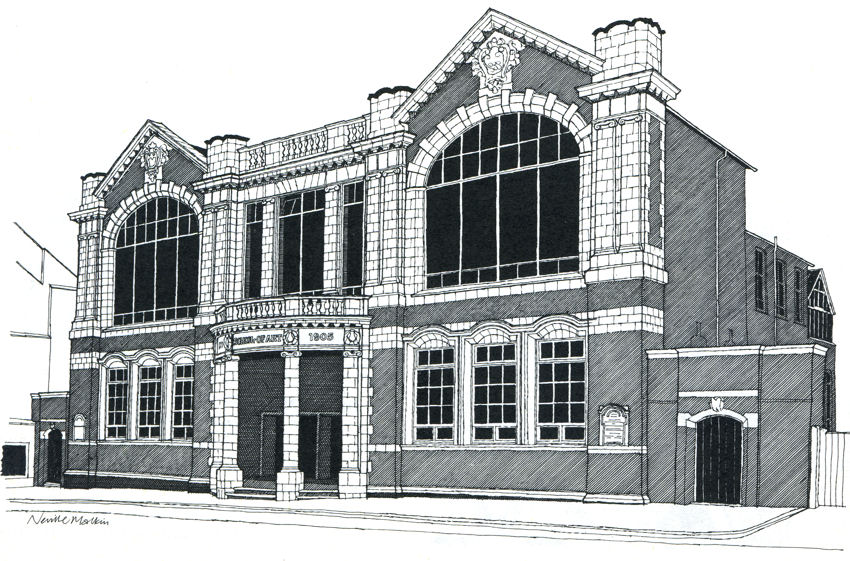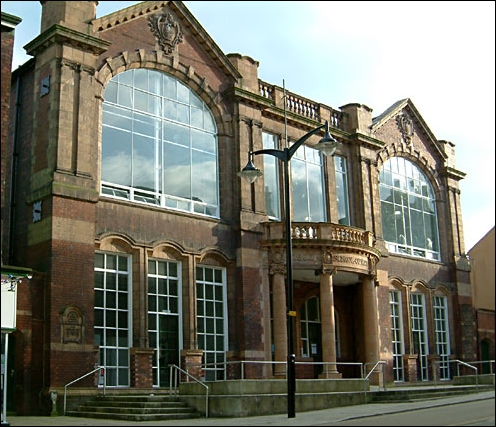|
|
|
![]() back to "The Grand Tour" index
back to "The Grand Tour" index
Neville Malkin's "Grand Tour" of the Potteries
buildings of
Burslem
![]()
![]()
![]()
next: St. John's Church,
Burslem
previous: The
Wedgwood Institute, Burslem
contents: index of buildings of Burslem
|
No 48 - Burslem School of Art
'The foundation stone of this building was
laid by the right honourable the Earl of Dartmouth,
|

Burslem School of Art
pen drawing by Neville Malkin -
July 1974

The School of Art was
constructed between 1900 and 1924 by W. Grant & Sons Builders.
It is a rectangular, two storey building, six rooms rooms wide by two rooms
deep.
The School of Art
(after refurbishment)
photo: 2002
|
"This
large, symmetrical, red brick and terracotta building in Queen Street,
Burslem, is the School of Art, designed by A. R. Wood and built during
1905-7. The decorative terracotta embellishments that supplement the
107ft. frontage were contributed by Doultons. The cost of the building
was about £6,000, with an extra £1,500 spent on furnishing the
spacious studies. The site had previously been occupied by an old
manufactory belonging to Wood and Baker, which, I think, was formerly
the works of a much earlier pottery owned by Cork and Condliffe. It
was donated by Thomas Hulme in 1904 for the sole purpose of erecting a
much-needed art school. On Friday, February 9th, 1906, the foundation stone was laid by the Earl of Dartmouth, who used a special engraved trowel. The trowel was silver with an ivory handle; it had an inscription-the Burslem coat of arms, and the motto "Ready." Deposited beneath the stone was an earthenware jar containing copies of the "Sentinel," the "Staffordshire Advertiser," a copy of the clays programme, and several coins of the period. Accompanying the jar were several examples of Burslem-made earthenware pots and ceramic tiles produced by the leading manufacturers. The main contributors were Doultons, Maddocks, Malkins, Wood and Sons, Wades, the Marsden Tile Company, and Messrs. Boote. The origins of the school can be traced back to a meeting in 1853 when representatives of the Stoke and Hanley Schools of Design met in the Wesleyan Schoolroom, Burslem, to discuss the possibility of creating a central art school that could be attended by students from the Six Towns and Newcastle, but, like most good ideas, it did not materialise overnight. In fact, it took more than 50 years before Burslem finally had an art school of its own and over 100 years before all the local art schools in the city were to unite as Stoke College of Art. This status was short-lived, however, because, with the founding of the North Staffordshire Polytechnic in 1970, the College of Art became the Faculty of Art and Design within this new system of tertiary education. Today, the Burslem School is an important part of the Polytechnic, accommodating the painting section of the Fine Art Department."
|
![]()
![]()
![]()
next: St. John's Church,
Burslem
previous: The
Wedgwood Institute, Burslem
contents: index of buildings of Burslem
back to "The Grand Tour" index